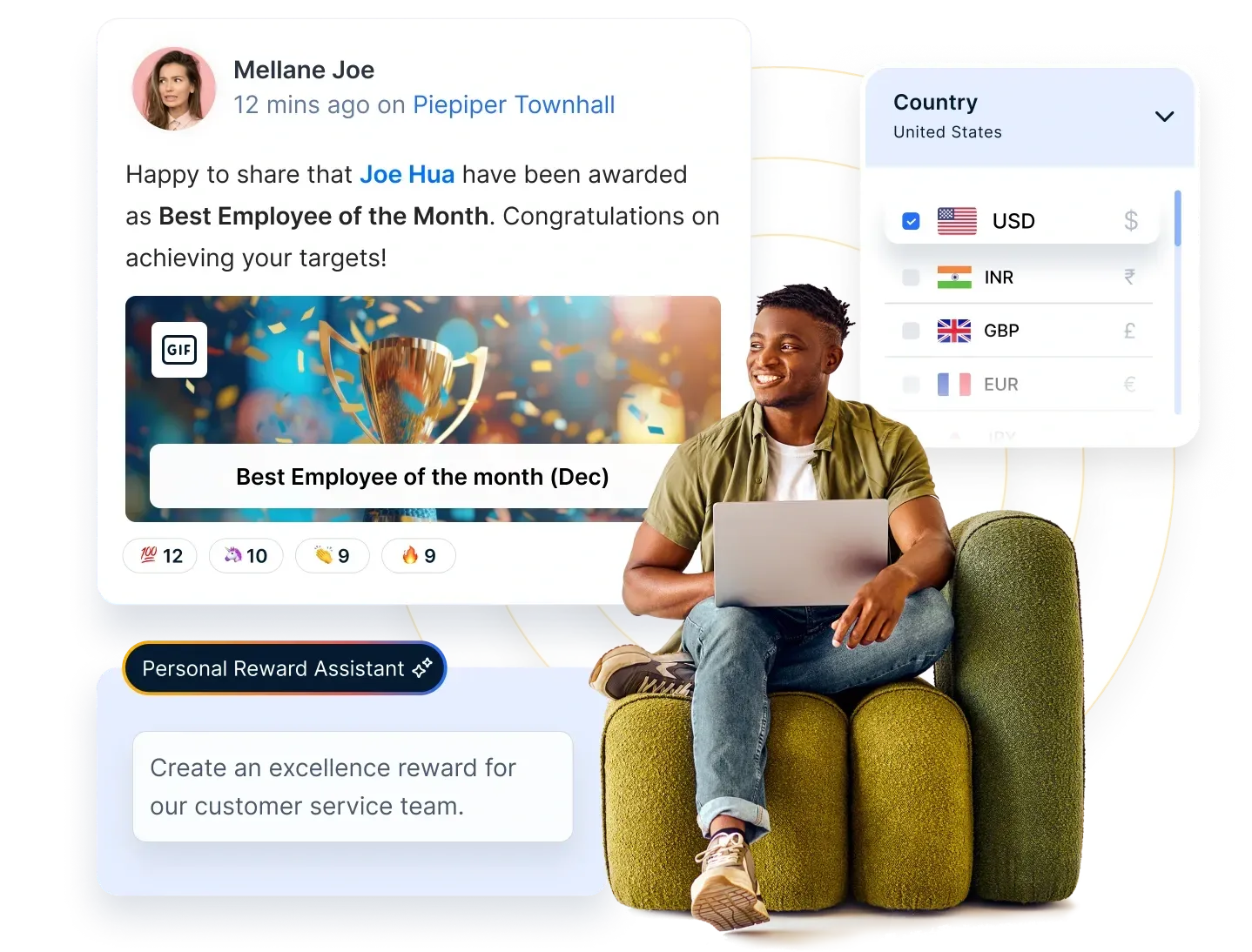Apa itu Motivasi Karyawan dan Mengapa Penting: Teori Motivasi yang Harus Anda Ketahui
Motivasi karyawan adalah kekuatan pendorong di balik produktivitas dan kesuksesan di tempat kerja. Memahami pentingnya motivasi karyawan membantu bisnis menciptakan lingkungan di mana karyawan merasa dihargai, dilibatkan, dan terinspirasi untuk melakukan yang terbaik.
Di halaman ini
- What is employee motivation: Meaning and definition
- 6 Employee motivation theories in the workplace
- Apa pentingnya motivasi karyawan dalam sebuah organisasi?
- Benefits of motivated employees in the workplace
- Implications of employee motivation from the purview of organizational behavior sciences
- Drive employee motivation with Empuls
- Kesimpulan
Employee motivation is the level of energy, commitment, and creativity that a company's workers bring to their jobs. Highly motivated employees wake up excited to take on new challenges, eager to learn, and ready to push their limits.
And motivation isn’t just about enthusiasm—it plays a direct role in business success. The importance of employee motivation lies in its ability to drive productivity, improve retention, and create a positive work environment where employees feel engaged and valued.
This is why businesses invest time in understanding what motivates employees and how to sustain that motivation over time. Many assume financial incentives are the primary driver, but motivation goes far beyond just compensation.
Studies on employee motivation theories highlight that factors like career growth, recognition, and workplace culture are equally—if not more—important in keeping employees engaged.
Figuring out what truly drives employees may seem like a challenge, but when businesses focus on what works, they can enhance motivation levels, boost overall performance, and create a stronger, more committed workforce.
What is employee motivation: Meaning and definition
Employee motivation is the driving force behind an employee’s performance, creativity, and overall contribution to an organization. It’s not just about the paycheck; it’s about feeling valued, having a sense of purpose, and being part of something bigger.
When employees are motivated, they are more likely to go the extra mile, resulting in higher productivity and a positive workplace culture.
Teknologi telah mengubah setiap aspek di tempat kerja, termasuk cara kita memotivasi karyawan. Saat ini, perusahaan dapat memanfaatkan alat bantu inovatif untuk menilai, memantau, dan meningkatkan motivasi karyawan, menciptakan lingkungan kerja yang lebih dinamis dan responsif. Alat-alat ini memungkinkan strategi motivasi yang dipersonalisasi yang dapat memenuhi kebutuhan individu, membuat motivasi lebih efektif dan berkelanjutan.
6 Employee motivation theories in the workplace
There are various theories and research on employee motivation. We'll discuss some of the important employee motivational theories in the workplace to explain employee motivation.
1. Teori motivasi hirarki kebutuhan Maslow tentang motivasi
Psychologist Abraham Maslow came up with this theory in his famous 1943 paper ‘A Theory of Human Motivation'.
Dasar dari teorinya adalah bahwa manusia perlu memenuhi kebutuhan paling dasar mereka sebelum mereka bisa mendapatkan motivasi untuk mencapai tujuan yang lebih tinggi.
Hirarkinya terdiri dari lima tingkatan:
- Fisiologis - kebutuhan dasar ini, seperti makanan, air, tidur, dan tempat tinggal, harus dipenuhi agar seseorang dapat bertahan hidup.
- Keamanan - kebutuhan ini membantu orang merasa aman dan mencakup kesehatan, kebebasan, serta keamanan pribadi dan finansial.
- Sosial - kebutuhan ini adalah untuk koneksi seperti cinta, pertemanan, hubungan, dan keluarga.
- Penghargaan - kebutuhan ini adalah merasa nyaman dengan diri sendiri, percaya diri, dihargai, dan diakui.
- Aktualisasi diri - puncak piramida adalah kebutuhan untuk menjadi diri Anda yang terbaik.
Teori ini masuk akal - jika Anda khawatir tentang dari mana makanan Anda berikutnya berasal dan bagaimana Anda akan membelinya, Anda tidak akan dapat melakukan banyak pemikiran terbaik tentang inisiatif strategis.
Apa artinya hal ini bagi motivasi karyawan?
Mendukung kebutuhan karyawan Anda di luar pekerjaan sangatlah penting. Mereka tidak akan mencapai semua yang mereka inginkan di tempat kerja jika mereka tidak yakin dengan gaji berikutnya atau sibuk dengan tugas-tugas harian.
Inilah sebabnya mengapa banyak perusahaan menawarkan fasilitas seperti fasilitas di tempat, jadwal kerja yang fleksibel, diskon kesehatan, dan banyak lagi.
Employees are not just workers - they’re human beings with complex needs and helping them fulfill more of those needs can allow them to shine when they’re at work and thrive outside of it too.
Menurut teori Maslow, untuk memahami motivasi seseorang dalam pekerjaannya, sebuah organisasi perlu memahami motivasi umum orang tersebut terlebih dahulu. Seorang karyawan pertama-tama ingin memenuhi kebutuhan fisiologisnya akan makanan, air, dan tempat tinggal.
Ketika hal ini terpenuhi, ia akan naik ke atas hierarki untuk memenuhi kebutuhan rasa aman, lalu ke kebutuhan berikutnya, dan seterusnya. Kebutuhan tertinggi dalam hierarki tersebut adalah aktualisasi diri yang mendorong seseorang untuk menjadi versi terbaik dari dirinya.
Seorang karyawan bekerja dengan cara menaiki hierarki ini dan setelah memenuhi tingkat kebutuhan apa pun, bercita-cita untuk tingkat kebutuhan berikutnya. Jadi, organisasi harus mengidentifikasi posisi setiap karyawan dalam hierarki kebutuhan dan memotivasinya untuk mencapai tingkat berikutnya.
Motivasi karyawan sesuai dengan teori ini dapat bergantung pada jenis industri Anda, ukuran perusahaan, dan tahap perusahaan saat ini. Misalnya, perusahaan dengan sebagian besar karyawan kerah putih memiliki kebutuhan motivasi yang berbeda dibandingkan dengan perusahaan yang memiliki sebagian besar karyawan kerah biru.
2. Teori dua faktor dari Hertzberg
Developed by psychologist Frederick Herzberg in the 1950s, the two-factor theory posits that two main factors significantly influence employee engagement and motivation.
- Faktor motivator adalah faktor yang memberikan motivasi positif kepada karyawan untuk melakukan yang terbaik dalam bekerja setiap hari. Faktor-faktor positif ini termasuk perasaan diakui dan dihargai, menikmati peran mereka, dan melihat jalur perkembangan karier yang jelas.
- Faktor higiene adalah faktor yang dapat membuat karyawan merasa tidak puas dan terdemotivasi ketika mereka tidak hadir. Faktor-faktor negatif ini dapat mencakup gaji, tunjangan, hubungan dengan rekan kerja dan manajer, dan kebijakan perusahaan.
Kedua faktor ini berkontribusi secara signifikan terhadap motivasi karyawan, namun keduanya bekerja secara independen satu sama lain. Anda perlu mengupayakan kedua faktor tersebut untuk benar-benar meningkatkan motivasi karyawan.
Mencegah motivasi yang rendah berarti menjaga faktor-faktor kebersihan tersebut, sehingga karyawan merasa dibayar dengan baik dan senang dengan orang-orang yang bekerja dengan mereka. Dan meningkatkan motivasi berarti mempromosikan faktor-faktor pendorong seperti memberikan pengakuan yang sering dan bermakna.
3. Teori motivasi penentuan nasib sendiri
Faktor eksternal memang penting bagi motivasi karyawan - namun juga bisa sangat membantu dan efektif untuk menyediakan kerangka kerja untuk meningkatkan motivasi internal.
That’s where the Self-Determination Theory comes in.
Teori ini menyatakan bahwa memenuhi tiga kebutuhan psikologis dasar karyawan membantu mendorong motivasi intrinsik dan kinerja berkualitas tinggi.
Ketiga kebutuhan internal dasar ini adalah:
- Keterkaitan, atau perasaan diperhatikan dan memiliki rasa memiliki yang kuat. Ini berarti membuat orang merasa didengar, dihargai, dan dihormati.
- Kompetensi, atau merasa efektif dan mengalami pertumbuhan. Mempercayai karyawan untuk melakukan pekerjaan mereka dengan baik sambil meminta pertanggungjawaban mereka atas tujuan yang dapat dicapai adalah faktor kunci di sini.
- Otonomi, atau memberdayakan karyawan untuk merasa bertanggung jawab atas tindakan mereka sendiri, dapat membuat pilihan mereka sendiri. Menghindari manajemen mikro dan mendorong karyawan untuk mengambil inisiatif sendiri dapat membantu memenuhi kebutuhan ini.
Teori motivasi karyawan ini adalah tentang menciptakan lingkungan tempat kerja yang membantu karyawan menjadi diri mereka yang terbaik.
The human need to grow, feel valued, and have confidence in skills is at the heart of this SHRM-approved theory, especially in difficult external times.
4. Teori ekspektasi motivasi
Teori ekspektasi Victor Vroom menyatakan bahwa motivasi seseorang bergantung pada tiga faktor: ekspektasi, instrumentalitas, dan valensi.
Hal ini membedakan antara upaya yang dilakukan oleh seseorang, kinerjanya, dan hasil akhirnya. Victor Vroom berpendapat bahwa ketika karyawan memiliki kebebasan untuk membuat pilihan dalam pekerjaan mereka, mereka biasanya memilih sesuatu yang paling memotivasi mereka.
People choose how they’ll behave as per the outcome they expect from that behavior - that’s the logic behind the Expectancy Theory. That means, in short, we decide what we’re going to do based on the outcome we expect. Humans are generally pretty rational creatures, and Expectancy Theory agrees with that notion.
Menurut teori ini,
Kekuatan Motivasi = Harapan x Instrumentalitas x Valensi
- Harapan: Apa yang diharapkan oleh karyawan dari upaya mereka sendiri.
- Instrumentalitas: Ini adalah tentang apakah kinerja karyawan cukup baik untuk mencapai hasil yang diinginkan.
- Valensi: yaitu seberapa besar Anda menghargai imbalan yang diharapkan.
To motivate an employee, there has to be a positive correlation between his effort and performance. An employee’s persona, his/her skills, and the expectations he/she has from his/her own abilities together form a motivating force for the employee. To keep up with and analyze the overall employee performance, consider using various employee time-tracking apps and task management tools.
Dalamteori ekspektasi motivasi, Victor Vroom menyarankan agar organisasi yang ingin memotivasi karyawan perlu memastikan bahwa ketiga faktor tersebut: Harapan, Instrumentalitas, dan Valensi adalah positif atau tinggi.
Ketiga faktor tersebut harus dicapai untuk memotivasi karyawan. Bahkan mencapai dua dari tiga faktor tersebut tidak akan memotivasi karyawan.
Teori ekspektasi juga menyatakan bahwa meskipun pemberi kerja telah menyediakan segalanya untuk memotivasi karyawan, karyawan masih belum sepenuhnya termotivasi kecuali dia percaya bahwa pemberi kerja benar-benar telah menyediakan apa yang dibutuhkan.
What does this all really mean? People are motivated to perform well if they believe there’s a reasonable chance, they’ll get a reward that they value.
So, if you’re trying to increase employee performance by handing out little ceramic sculptures of frogs as a reward for good work, employees might think they have a good chance of getting that reward - but it’s not really valuable.
Di sisi lain, jika kenaikan gaji sangat dihargai namun jarang dilakukan di perusahaan Anda, karyawan mungkin tidak akan termotivasi karena mereka tidak melihat adanya kemungkinan besar kenaikan gaji yang layak dalam waktu dekat. Sebagai gantinya, cobalah untuk menetapkan tujuan yang harus dicapai oleh karyawan Anda dan kemudian berikan imbalan untuk tujuan yang benar-benar mereka inginkan.
5. Teori atribusi tiga dimensi
Manusia selalu mencari makna dalam segala hal yang terjadi pada kita. Ini adalah dasar di balik Teori Atribusi Tiga Dimensi, yang dikembangkan oleh Bernard Weiner.
Dikatakan bahwa orang mencoba menentukan mengapa kita melakukan apa yang kita lakukan, dan alasan yang kita coba temukan dalam perilaku kita memengaruhi cara kita bertindak di masa depan.
Teori ini bermuara pada tiga karakteristik utama yang cenderung kita kaitkan dengan perilaku.
- Apakah kita melihat masalah sebagai sesuatu yang bersifat sementara, seperti tidur yang tidak nyenyak? Atau apakah itu masalah yang berkelanjutan dan stabil, seperti ketidaklayakan diri kita sendiri?
- Apakah kita percaya bahwa masalahnya disebabkan oleh peristiwa eksternal, seperti komputer presentasi yang rusak? Atau apakah kita menemukan masalahnya secara internal karena kurangnya kecerdasan kita sendiri?
- Apakah faktor-faktor untuk menyajikan dengan baik berada di dalam kendali kami atau di luar kendali kami? Apakah kurangnya persiapan yang dapat kami kendalikan atau pemadaman internet yang berada di luar kendali kami?
Ketika orang merasa tidak memiliki kekuatan dan keterampilan bawaan, mereka dapat menceritakan kisah-kisah kekalahan tentang diri mereka sendiri yang menyebabkan mereka putus asa untuk berkembang. Dan itu adalah perasaan yang sangat menurunkan motivasi.
Di sisi lain, ketika karyawan merasa dapat mengendalikan lebih banyak faktor yang menyebabkan masalah dan mengetahui cara memperbaikinya, mereka lebih mungkin melakukan perbaikan dan merasa termotivasi untuk melakukan yang lebih baik.
6. Teori dorongan
Teori dorongan yang dikreditkan oleh akademisi Amerika, Richard H Thaler dan Cass R Sunstein, memotivasi karyawan untuk mengambil keputusan yang sesuai dengan kepentingan mereka.
Organisasi dapat mengukur cara berpikir setiap karyawannya dan memudahkan mereka untuk memilih apa yang terbaik bagi mereka, keluarga, dan masyarakat.
Teori dorongan juga dapat digunakan untuk mengeksplorasi dan memahami pengaruh terhadap perilaku seseorang, terutama melihat pengaruh negatif, dengan tujuan untuk menyingkirkannya. Teori ini dengan jelas menerima bahwa orang memiliki sikap dan kemampuan tertentu dan menganggapnya sebagai bagian dari kecenderungan manusia.
Organisasi tidak dapat memaksa karyawan untuk mengadopsi perilaku tertentu atau mengikuti seperangkat aturan. Mereka hanya dapat mengubah perilaku karyawan terhadap sesuatu tanpa memaksanya.
Mereka dapat dengan mudah mendorong atau mempengaruhi mereka untuk mengambil keputusan yang tepat. Salah satu cara untuk melakukannya adalah dengan memberikan referensi dari perilaku orang lain untuk menyoroti apa yang dapat diterima dan diinginkan.
Apa pentingnya motivasi karyawan dalam sebuah organisasi?
Employee motivation is the energy, commitment, and enthusiasm employees bring to work. Motivated employees enjoy their jobs, strive to do their best, and seek growth beyond just a paycheck. While no one stays motivated every day, engaged employees bring enthusiasm most of the time.
However, many businesses struggle with keeping employees motivated. It requires thoughtful effort to maintain engagement throughout a career. Motivated employees not only excel in their roles but also inspire those around them. When in leadership positions, they drive teams toward success with focus and positive energy.
On the other hand, unmotivated employees often feel bored, dissatisfied, or burnt out. Managers play a key role in fostering motivation, making leadership essential in building an engaged and productive workforce.
According to Gallup, only two out of ten employees strongly agree their performance is managed in a way that motivates them to do outstanding work.
Itu adalah kesenjangan motivasi yang signifikan. Dan karena ada begitu banyak manfaat dari memiliki karyawan yang memiliki motivasi tinggi, kesenjangan tersebut sangat disayangkan.

Jaga Karyawan Anda Tetap Termotivasi & Terlibat
A paycheck isn’t enough employees thrive on recognition, meaningful rewards, and a sense of belonging. With Empuls, celebrate achievements and boost motivation effortlessly.
Benefits of motivated employees in the workplace
How do companies benefit from having plenty of motivated employees? Here are the seven important benefits of motivated employees in the workplace:
1. Lebih banyak inovasi
Employees who genuinely enjoy their jobs and feel motivated to do their best are also motivated to frequently develop new improvements and ideas.
Motivated employees, unburdened by self-limiting beliefs, have the energy and enthusiasm to be real innovators on their teams and the company.
Mereka akan melihat area yang memungkinkan untuk ditingkatkan dan bersedia untuk mewujudkannya, dan bisnis Anda akan menjadi sangat inovatif sebagai hasilnya.
2. Keterlibatan karyawan yang tinggi
Working with a whole group of demotivated employees can drag down even a highly engaged employee.
But on the other hand, joining a team of motivated employees can help increase overall engagement rates and help employees have more commitment to their workplace and work.
And since engaged employees are such an asset to your business, raising overall engagement rates has many benefits. Motivation and engagement tend to go hand-in-hand.
3. Karyawan yang lebih efisien
Karyawan yang menyelesaikan lebih banyak hal dalam waktu yang lebih singkat sangat berharga. Mereka dapat menyelesaikan banyak hal dalam waktu yang sama dibandingkan dengan karyawan lain. Dan jika pekerjaan mereka sangat berkualitas tinggi, Anda dapat melihat peningkatan produktivitas yang besar dengan tim karyawan yang termotivasi.
Karyawan yang termotivasi akan menjadi efisien karena mereka bersemangat untuk menyelesaikan tugas mereka dan melakukan pekerjaan dengan baik.
4. Tingkat perputaran yang lebih rendah
Employees who aren’t motivated or engaged at work have higher turnover rates - especially when it comes to your top performers.
Di sisi lain, karyawan yang termotivasi melihat dampak dari pekerjaan mereka terhadap tim atau perusahaan dan merasa terinspirasi untuk tetap tinggal dan terus berkontribusi pada tingkat yang tinggi. Mempertahankan karyawan yang sangat produktif dan energik ini sangat bagus untuk bisnis Anda.
5. Meningkatkan kepuasan kerja
Job satisfaction determines an employee’s performance to a great extent. Higher job satisfaction would also mean a lower attrition rate in an organization. Getting a handsome salary is one thing but today’s employees look for satisfaction in their careers.
Employees who feel their voice is heard are 4.6 times more empowered to perform their best work. (Source: SalesForce)
6. Meningkatkan semangat kerja karyawan
Motivasi dan semangat kerja berjalan beriringan, dan semangat kerja merupakan indikator seberapa bahagia karyawan suatu organisasi.
Mendorong karyawan untuk mengambil keputusan di tempat kerja, membuat pekerjaan mereka lebih bermakna, memberi karyawan rasa tanggung jawab dan otoritas, serta mendorong kreativitas adalah cara-cara untuk meningkatkan motivasi dan semangat kerja.
7. Self-discipline
Motivasi mendorong disiplin diri di antara para karyawan. Disiplin diri membantu karyawan mencapai lebih banyak hal daripada disiplin yang dipaksakan oleh senior mereka.
Karyawan yang termotivasi mendisiplinkan diri mereka sendiri dan percaya bahwa hal tersebut diperlukan untuk kepentingan mereka.
Implications of employee motivation from the purview of organizational behavior sciences
Mempelajari motivasi karyawan dari lingkup ilmu perilaku organisasi membantu praktisi Sumber Daya Manusia lebih dekat untuk mencapai motivasi di tempat kerja mereka. Penelitian pekerjaan menguraikannya untuk membantu kita memahami anteseden motivasi karyawan secara terpisah.
Pemahaman yang lebih baik tentang manfaat motivasi karyawan akan memberikan jalan menuju pencapaian yang lebih baik. Mari kita lihat apa yang dikatakan oleh para peneliti tentang manfaat karyawan yang termotivasi.
Innumerous studies have been conducted to understand what motivates employees and the following are the most important factors that decide the employee’s motivation.
1. Employee involvement: A feeling of being involved
Employee involvement or Employee participation is said to have the maximum on the employee’s motivation. Employee involvement can be created in an organization by creating an environment where employees can influence the decisions and actions that affect their jobs. This is more of a management and leadership philosophy than a strategy and it enables people to continuously contribute to the success of the organization.

Disengaged employees cost U.S. companies up to $550 billion a year - The Engagement Institute—a joint study by The Conference Board, Sirota-Mercer, Deloitte, ROI, The Culture Works and Consulting LLP
Berikut ini adalah beberapa cara untuk meningkatkan partisipasi karyawan:
0️⃣ Job security
Jaminan penghasilan tetap adalah motivasi utama untuk bekerja dan keamanan kerja adalah ukuran dari jaminan ini. Keamanan kerja mengacu pada kemungkinan kehilangan atau mempertahankan pekerjaan seseorang dan memiliki pengaruh yang besar terhadap tingkat motivasi karyawan.
89% of workers at companies with well-being initiatives would recommend their company as a good place to work- American Psychological Association
Ada beberapa faktor yang memengaruhi persepsi keamanan kerja karyawan dan berikut ini adalah yang paling penting:
1️⃣ Trust
Jumlah kepercayaan yang dimiliki karyawan terhadap organisasi dan manajer mereka mempengaruhi jumlah keamanan kerja yang dirasakan karena kepercayaan didefinisikan sebagai harapan untuk mengandalkan sesuatu. Kepercayaan ini dapat bersifat relasional - berdasarkan hubungan pribadi antara manajer dan bawahan - atau dapat dihitung - berdasarkan kemampuan manajer atau bawahan.
People at high-trust companies experience 74% less stress. - Harvard Busines Review
2️⃣Self-efficacy
Efikasi diri adalah cara karyawan menilai kinerja mereka sendiri dalam peran pekerjaan mereka. Persepsi kinerja karyawan dalam perannya memainkan peran penting dalam keamanan kerja karena kemungkinan untuk mempertahankan seseorang dalam suatu pekerjaan meningkat seiring dengan kinerjanya.
3️⃣Task-oriented leadership
Kepemimpinan yang berorientasi pada tugas atau manajemen yang berfokus pada tujuan mengacu pada saat seorang pemimpin mendorong penyelesaian tugas, meningkatkan kejelasan tujuan, secara terus-menerus meningkatkan efisiensi komunikasi, dan mengatur perilaku karyawan yang tidak produktif.
Almost $7 trillion are lost in the name of unproductive employees - Gallup
Ketika karyawan memiliki instruksi yang tepat tentang tugas dan tahu persis apa yang harus dilakukan, maka tugas-tugas tersebut akan diselesaikan. Pemimpin yang berorientasi pada tugas dianggap memberikan keamanan kerja yang lebih baik karena peningkatan probabilitas penyelesaian tugas ini mengarah pada pekerjaan yang lebih aman.
4️⃣ Organizational Identification
Identifikasi organisasi terjadi ketika karyawan mengidentifikasikan diri dengan organisasi, memiliki keberhasilan dan kegagalan organisasi sebagai bagian dari dirinya. Karyawan dengan identifikasi organisasi yang lebih tinggi cenderung merasakan keamanan kerja yang lebih baik karena mereka cenderung mengambil tanggung jawab untuk menanamkan keamanan kerja sebagai milik mereka sendiri.
5️⃣ Supervisor’s help with personal problems
Kemampuan supervisor untuk berempati dan membantu menyelesaikan masalah pribadi karyawan mempengaruhi motivasi karyawan. Faktor penentu eksternal dari motivasi karyawan dan penurunan produktivitas adalah masalah pribadi mereka.
19% of employees view their bosses as mentors, people they can learn from and trust - Monster
Ketika supervisor benar-benar mencoba untuk terhubung dengan karyawan, dalam upaya untuk memperhatikan dan mengakomodasi masalah-masalah ini, karyawan akan terbebas dari ketegangan akibat masalah-masalah di luar pekerjaan mereka. Pengurangan stres dan kecemasan ini akan mengarah pada pemulihan motivasi karyawan.
6️⃣ Good Wages
Upah nominal untuk bekerja merupakan kebutuhan fisiologis bagi seorang karyawan. Dengan upah inilah semua kebutuhan dasarnya dapat terpenuhi. Upah juga dapat diklasifikasikan sebagai faktor higiene, yang kekurangannya dapat menyebabkan ketidakpuasan yang ekstrim. Pengamatan yang paling menarik seputar upah adalah bahwa motivasi karyawan tidak berbanding lurus dengan kenaikan upah. Faktanya, ada beberapa penelitian yang menunjukkan skor motivasi karyawan yang sama di seluruh golongan upah.
7️⃣ Interesting work
Pengayaan pekerjaan adalah cara untuk membuat pekerjaan menjadi menarik dan menantang, yang akan meningkatkan keahlian dan tingkat motivasi. Hal ini dapat dicapai melalui:
- Memastikan bahwa tujuan individu dan bagaimana tujuan tersebut sesuai dengan misi perusahaan secara keseluruhan dipahami secara menyeluruh oleh para karyawan.
- Menyediakan sumber daya seperti TI, alat komunikasi, dan pelatihan bagi setiap karyawan agar dapat bekerja dengan baik.
- Menciptakan jaringan dukungan sebaya dan manajemen yang mendukung - untuk memastikan lingkungan yang kondusif.
- Menciptakan transparansi dan aliran informasi yang bebas di seluruh organisasi.
- Memberikan otonomi dan menghargai inisiatif karyawan.
- Memberikan penghargaan dan pengakuan yang memadai.
- Memberikan kesempatan untuk meningkatkan keterampilan, seperti pelatihan yang dibayar penuh dan tiket masuk ke konferensi.
- Menyediakan variasi pekerjaan melalui program pembagian kerja dan rotasi pekerjaan.
8️⃣Tactful discipline
Mendisiplinkan karyawan secara bijaksana merupakan faktor penting dalam motivasi. Hal ini dapat dilakukan dengan:
- Memberikan panduan yang jelas untuk bekerja.
- Merencanakan dan memproyeksikan area hasil utama dengan sangat akurat.
- Menjaga percakapan tetap terbuka dan bertujuan untuk menemukan akar penyebab masalah.
- Berhati-hatilah dalam memberikan umpan balik negatif - sadarilah untuk tidak membuat proses ini menjadi lebih personal dengan cara apa pun.
- Selalu memberikan umpan balik negatif secara pribadi.
- Menjaga kerahasiaan sepenuhnya terkait masalah tersebut dan bekerja sama dengan karyawan untuk menyelesaikannya.
- Terus-menerus meyakinkan kepercayaan diri karyawan.
- Memberikan beberapa kali instruksi dan umpan balik yang konstruktif, hingga masalah terselesaikan.
9️⃣ Promotion or career development
Kesempatan untuk promosi dan pengembangan karir sangat mempengaruhi tingkat motivasi karyawan. Kesempatan pengembangan karir ini dapat berupa kenaikan gaji atau perluasan cakupan wewenang, tugas dan tanggung jawab. Bahkan bisa juga berupa perubahan lokasi atau wilayah kerja. Perubahan ini dapat dilakukan berdasarkan kecakapan, pengalaman kerja, atau pelatihan.
🔟 Good working conditions
Kondisi kerja suatu organisasi dapat memengaruhi kesehatan dan keselamatan, keamanan, dan jam kerja karyawan.
61% of employees are burned out on the job - CareerBuilder
Employers have a general duty to ensure that the working conditions are as per statutory mandates. This includes managing the maintenance, ventilation, temperature, ambiance, workstations, facilities, and interiors of the office so as to ensure a congenial working environment. This also includes proper communication and online safety training for precautions and usage of work tools.
2. Increased employee productivity
Several studies have proven a strong correlation between employee motivation and performance. In fact, one of the most important benefits of motivated employees is the amount of productivity enhancement it brings.
The effects of motivation on employee productivity not only are the actual quantitative and qualitative outcomes of their tasks significantly better, but the employees also themselves perceive their performances as good. This positive perception and conviction allow them to increasingly improve their performances further.
45% of employees complain that outdated versions of software keep them from being productive - Unisys
3. Kepuasan karyawan
Motivated employees tend to believe that their organizations allow them to grow as an individual and enable them to effectively contribute to the organization - thus driving the effectiveness of employee initiatives.
They also tend to positively perceive the organization’s environment to be cooperative, fair, and trustworthy. They feel that the organization is genuinely interested in their wellbeing and resultantly score high on employee satisfaction scores and promoter scores.
81% of employers that offer benefits agree that their company’s benefits offerings increase employee satisfaction - Aflac
4. Improved employee organizational citizenship behavior
The increased employee satisfaction enables the employees to empathize with organizational goals, ethics, and moral values. This results in employees exhibiting behaviors that account for organizational citizenship behavior.
These are characterized as actions and behaviors that go beyond their normal job responsibilities but benefit the team and organizational functioning and efficiency.
Drive employee motivation with Empuls

Keeping employees motivated goes beyond paychecks—it’s about recognition, engagement, and a strong sense of belonging. Empuls makes this easy with a comprehensive platform for rewards, recognition, engagement tracking, and workplace culture enhancement.
- Recognize & reward achievements: Celebrate milestones, performance, and contributions with real-time recognition and meaningful rewards.
- Measure motivation & engagement: Use AI-driven surveys to track engagement and gain insights into employee sentiment.
- Enhance workplace culture: Foster collaboration and connection with social intranet and culture-building tools.
- Offer meaningful perks: Boost satisfaction with fringe benefits that employees truly value.
With Empuls, businesses can create a motivated workforce that feels valued, connected, and driven to succeed. Ready to build a culture of motivation? Get started with Empuls today!
Kesimpulan
The importance of employee motivation lies in its impact on productivity, job satisfaction, and business success. A motivated workforce drives innovation and retention, but it’s up to organizations to create an environment that fosters engagement and growth.
For decades, employee motivation theories like the Maslow’s hierarchy of needs, Hertzberg’s two-factor theory, and Expectancy theory of motivation have helped businesses understand what drives employees. Using these insights, companies can implement strategies that keep their workforce engaged.
To simplify motivation, engagement tracking, and rewards, Empuls offers an all-in-one solution.
Boost employee motivation with Empuls. Get started today!













